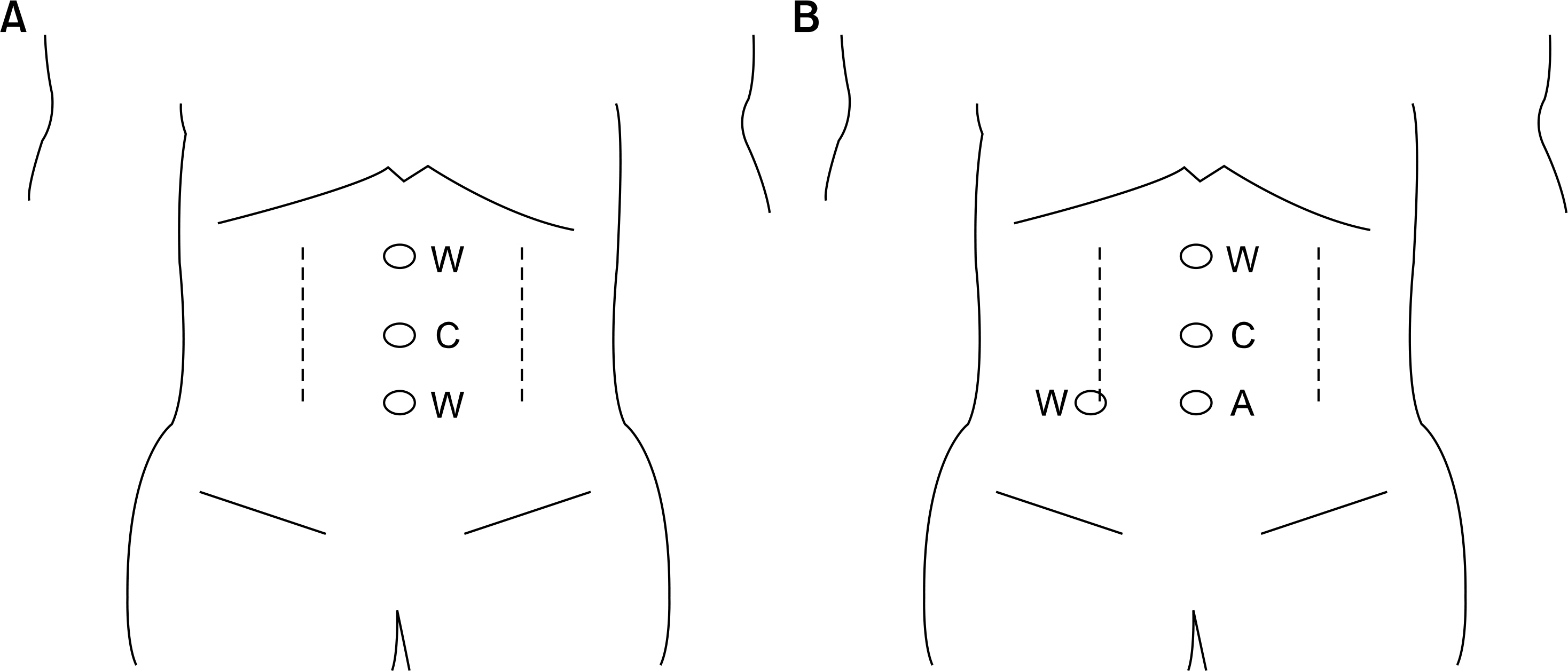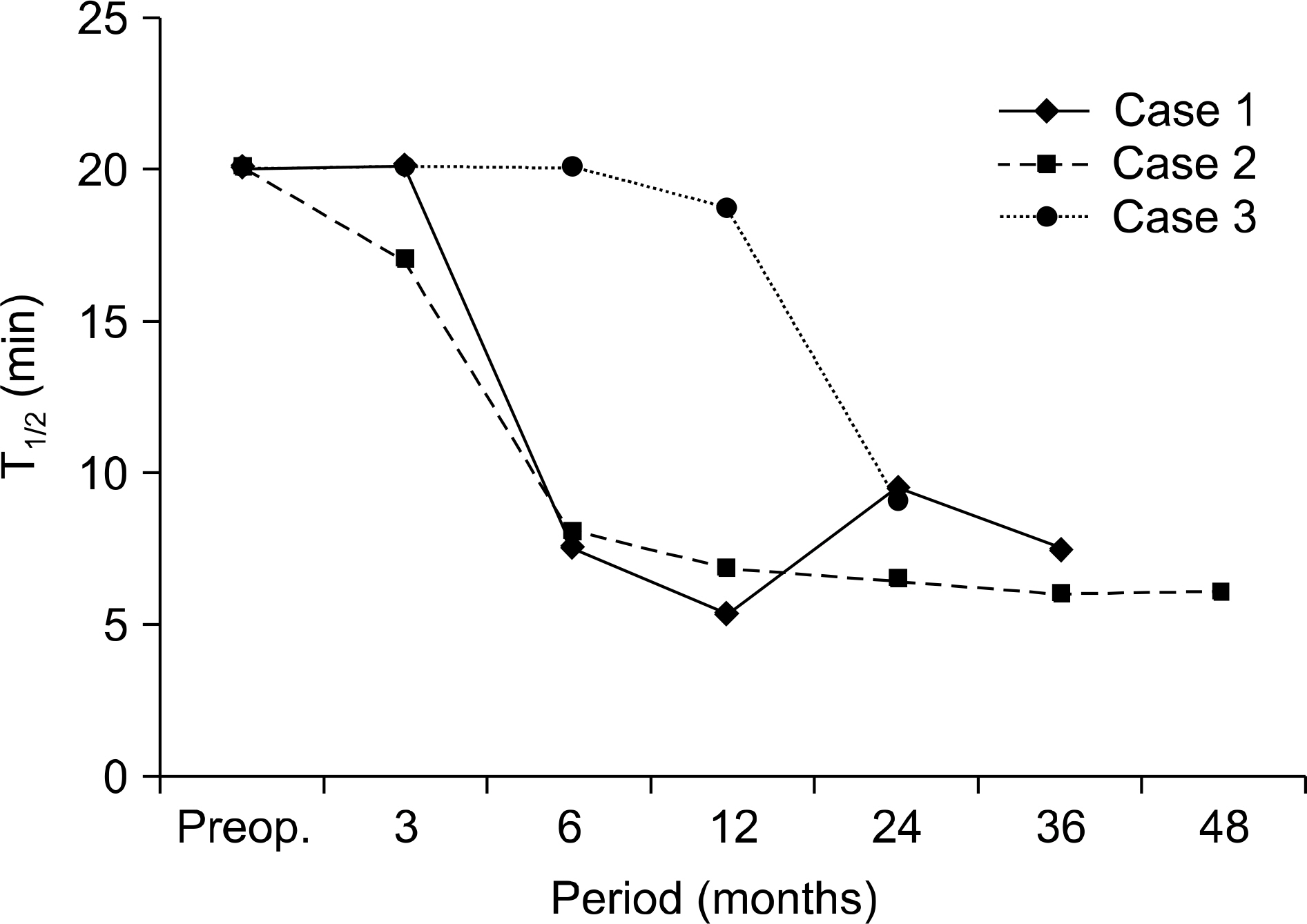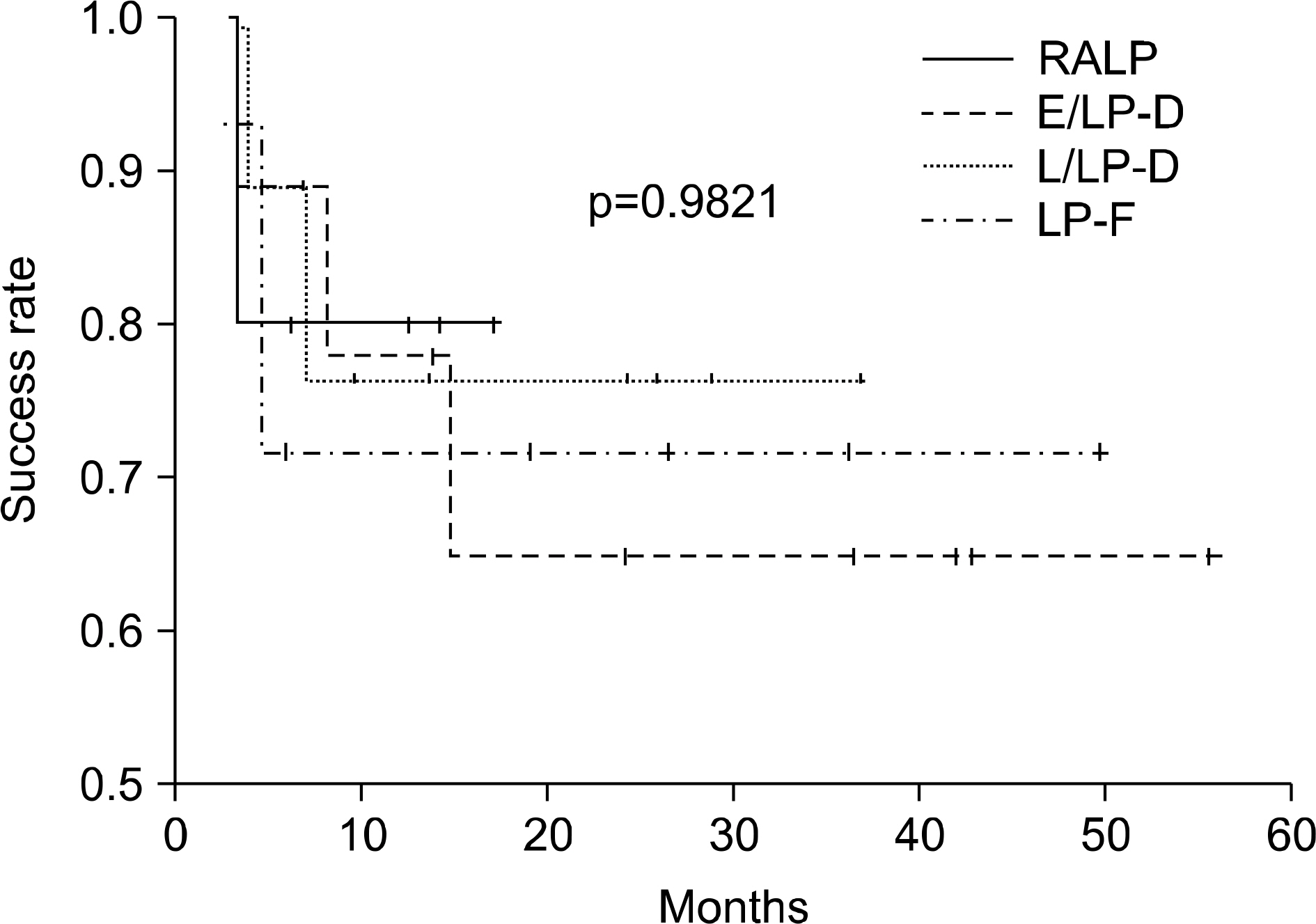Korean J Urol.
2009 Oct;50(10):996-1002.
Experience with Laparoscopic Pyeloplasty, Including Robot-Assisted Laparoscopic Surgery, for Ureteropelvic Junction Obstruction
- Affiliations
-
- 1Department of Urology, University of Ulsan College of Medicine, Seoul, Korea. hkpark@amc.seoul.kr
Abstract
- PURPOSE
Laparoscopic pyeloplasty was developed as a minimally invasive alternative to an open procedure for the treatment of ureteropelvic junction (UPJ) obstruction. We present our experience with the first 30 consecutive cases of laparoscopic pyeloplasty performed at our institution.
MATERIALS AND METHODS
We studied 30 patients with ureteropelvic junction obstructions who underwent laparoscopic pyeloplasty between March 2004 and March 2009. Of the 30 patients, 5 patients underwent robot-assisted laparoscopic pyeloplasty (RALP) since April 2008. Patients were divided into 4 groups according to operative procedure: group 1, early laparoscopic pyeloplasty-dismembered (E/LP-D, n=9); group 2, late laparoscopic pyeloplasty-dismembered (L/LP-D, n=9); group 3, laparoscopic pyeloplasty-Fenger's method (LP-F, n=7); and group 4, RALP (n=5).
RESULTS
The mean age of the patients was 34.0+/-12.8 years (range, 17-61 years). A crossing vessel was present in 37.9% of cases. Mean follow-up was 30+/-14 months (range, 11-62 months). Mean operative time was 267.3+/-78.7 minutes (range, 154-460 minutes), and the average length of the postoperative hospital stay was 4.6+/-1.6 days (range, 3-10 days). There were no intraoperative complications or transfusion. The success rate was 73.3%. The success rates of E/LP-D, L/LP-D, LP-F, and RALP were 6/9 (66.7%), 7/9 (77.8%), 5/7 (71.4%), and 4/5 (80%), respectively, without significant difference (p>0.05). Operation time and length of hospital stay were shorter in the L/LP-D group than in the E/LP-D group.
CONCLUSIONS
Laparoscopic pyeloplasty may be an alternative treatment for an ureteropelvic junction obstruction, but the technical complexity of the procedure has made it difficult for many surgeons to adopt. RALP is a technically feasible management option for UPJ obstruction.
Keyword
MeSH Terms
Figure
Reference
-
1.Wickham JE., Kellet MJ. Percutaneous pyelolysis. Eur Urol. 1983. 9:122–4.
Article2.Schuessler WW., Grune MT., Tecuanhuey LV., Preminger GM. Laparoscopic dismembered pyeloplasty. J Urol. 1993. 150:1795–9.
Article3.Klingler HC., Remzi M., Janetschek G., Kratzik C., Marberger MJ. Comparison of open versus laparoscopic pyeloplasty techniques in treatment of uretero-pelvic junction obstruction. Eur Urol. 2003. 44:340–5.
Article4.Smith JA Jr. Robotically assisted laparoscopic prostatectomy: an assessment of its contemporary role in the surgical management of localized prostate cancer. Am J Surg. 2004. 188(4A Suppl):63S–7.
Article5.Fernbach SK., Maizels M., Conway JJ. Ultrasound grading of hydronephrosis: introduction to the system used by the Society for Fetal Urology. Pediatr Radiol. 1993. 23:478–80.
Article6.Lowe FC., Marshall FF. Ureteropelvic junction obstruction in adults. Urology. 1984. 23:331–5.
Article7.O'Reilly PH., Brooman PJ., Mak S., Jones M., Pickup C., Atkinson C, et al. The long-term results of Anderson-Hynes pyeloplasty. BJU Int. 2001. 87:287–9.8.Anderson JC., Hynes W. Retrocaval ureter; a case diagnosed pre-operatively and treated successfully by a plastic operation. Br J Urol. 1949. 21:209–14.9.Tan BJ., Smith AD. Ureteropelvic junction obstruction repair: when, how, what? Curr Opin Urol. 2004. 14:55–9.
Article10.Tawfiek ER., Liu JB., Bagley DH. Ureteroscopic treatment of ureteropelvic junction obstruction. J Urol. 1998. 160:1643–6.
Article11.Shalhav AL., Giusti G., Elbahnasy AM., Hoenig DM., McDougall EM., Smith DS, et al. Adult endopyelotomy: impact of etiology and antegrade versus retrograde approach on outcome. J Urol. 1998. 160:685–9.
Article12.Adeyoju AB., Hrouda D., Gill IS. Laparoscopic pyeloplasty: the first decade. BJU Int. 2004. 94:264–7.
Article13.Han DY., Park KS., Seo IY., Rim JS. A comparison of minimally invasive surgical techniques for ureteropelvic junction obstructions: endopyelotomy, acucise endopyelotomy, and laparoscopic pyeloplasty. Korean J Urol. 2008. 49:592–7.
Article14.Dimarco DS., Gettman MT., McGee SM., Chow GK., Leroy AJ., Slezak J, et al. Long-term success of antegrade endopyelotomy compared with pyeloplasty at a single institution. J Endourol. 2006. 20:707–12.15.Janetschek G., Peschel R., Frauscher F. Laparoscopic pyelo- plasty. Urol Clin North Am. 2000. 27:695–704.16.Jarrett TW., Chan DY., Charambura TC., Fugita O., Kavoussi LR. Laparoscopic pyeloplasty: the first 100 cases. J Urol. 2002. 167:1253–6.
Article17.Kavoussi LR., Peters CA. Laparoscopic pyeloplasty. J Urol. 1993. 150:1891–4.
Article18.Sundaram CP., Grubb RL 3rd., Rehman J., Yan Y., Chen C., Landman J, et al. Laparoscopic pyeloplasty for secondary ureteropelvic junction obstruction. J Urol. 2003. 169:2037–40.
Article19.Hwangbo K., Seo SI., Kim JC., Hwang TK. Retroperitoneo-scopic pyeloplasty. Korean J Urol. 2003. 44:624–7.20.Kim BS., Woo SH., Han HY., Lee SB. Initial experience of laparoscopic pyeloplasty: retrograde stenting using flexible cystoscopes. Korean J Urol. 2006. 47:1302–8.
Article21.Iwamura M., Soh S., Irie A., Kadowaki K., Matsusita Y., Fujioka T, et al. Laparoscopic pyeloplasty for ureteropelvic junction obstruction: outcome of initial 12 procedures. Int J Urol. 2004. 11:449–55.
Article22.Sarle R., Tewari A., Shrivastava A., Peabody J., Menon M. Surgical robotics and laparoscopic training drills. J Endourol. 2004. 18:63–6.
Article23.Partin AW., Adams JB., Moore RG., Kavoussi LR. Complete robot-assisted laparoscopic urologic surgery: a preliminary report. J Am Coll Surg. 1995. 181:552–7.24.Gettman MT., Neururer R., Bartsch G., Peschel R. Anderson-Hynes dismembered pyeloplasty performed using the da Vinci robotic system. Urology. 2002. 60:509–13.
Article25.Mitre AI., Brito AH., Srougi M. Laparoscopic dismembered pyeloplasty in 47 cases. Clinics. 2008. 63:631–6.
Article26.Inagaki T., Rha KH., Ong AM., Kavoussi LR., Jarrett TW. Laparoscopic pyeloplasty: current status. BJU Int. 2005. 95(Suppl 2):102–5.
Article27.Seo IY., Park SC., Oh SJ. Laparoscopic pyeloplasty with transperitoneal approach for ureteropelvic obstruction. Korean J Urol. 2005. 46:370–4.28.Mufarrij PW., Shah OD., Berger AD., Stifelman MD. Robotic reconstruction of the upper urinary tract. J Urol. 2007. 178:2002–5.
Article29.Weise ES., Winfield HN. Robotic computer-assisted pyeloplasty versus conventional laparoscopic pyeloplasty. J Endourol. 2006. 20:813–9.
Article30.Link RE., Bhayani SB., Kavoussi LR. A prospective comparison of robotic and laparoscopic pyeloplasty. Ann Surg. 2006. 243:486–91.
Article
- Full Text Links
- Actions
-
Cited
- CITED
-
- Close
- Share
- Similar articles
-
- Laparoscopy-Assisted Extracorporeal Ureteral Anastomosis : a New Technique
- Experiences on Anderson-Hynes Pyeloplasty
- Management of the Ureteropelvic Junction Obstruction
- Laparoscopic Pyeloplasty with Transperitoneal Approach for Ureteropelvic Obstruction
- Endopyelotomy as a Treatment for Ureteropelvic Junction Obstruction: 3 Cases




